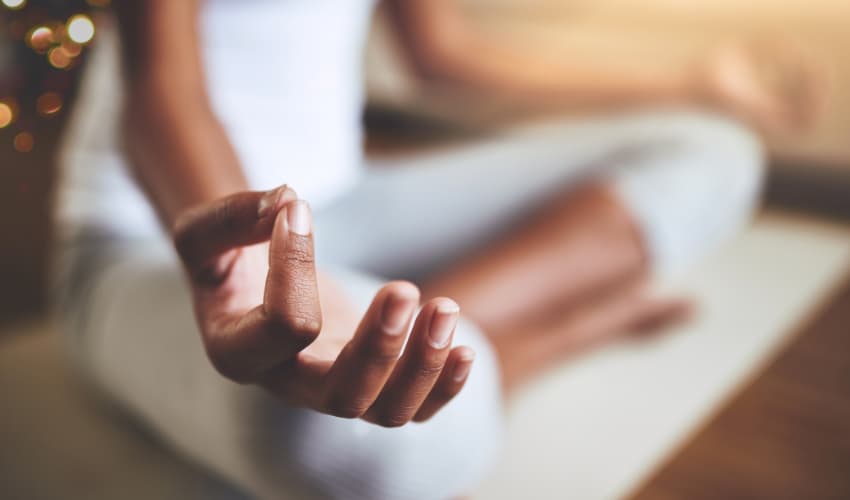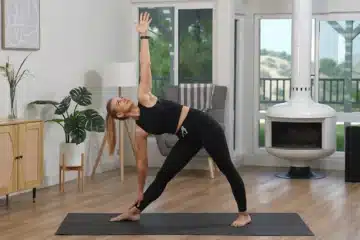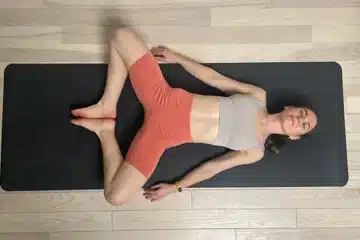Mindful breathing techniques in yoga for beginners focus on deep, controlled breaths to promote relaxation and mindfulness. These techniques help individuals develop a greater awareness of their breath and body, enhancing the overall yoga experience.
By concentrating on the breath, beginners can calm the mind and relieve stress while improving their physical practice. Yoga emphasizes the connection between breath and movement, making mindful breathing an essential component for beginners. This practice allows individuals to cultivate a sense of presence and focus, which can be particularly beneficial for those new to yoga.
Additionally, mindful breathing techniques lay the foundation for more advanced practices, making them a valuable skill to develop early in one’s yoga journey. Learning these techniques sets the stage for a fulfilling and transformative yoga experience, both physically and mentally.
Getting Started With Yoga
If you’re new to the world of yoga, the prospect of beginning your practice can feel both exciting and a little overwhelming. One of the best ways to start your yoga journey is by focusing on mindful breathing techniques.
Why Yoga?
Yoga is an ancient practice that not only helps to improve physical strength and flexibility, but also promotes mental clarity and emotional well-being. It offers a holistic approach to health and wellness, making it an ideal choice for beginners looking to enhance their overall well-being.
Choosing The Right Yoga Style
When starting out, it’s important to choose a yoga style that aligns with your goals and interests. Some popular yoga styles for beginners include Hatha, Vinyasa, and Restorative yoga. Each style offers its own unique benefits, so take some time to explore and find the one that resonates with you.

Credit: junglegayborhood.com
Understanding Mindful Breathing
Understanding Mindful Breathing is the foundation for achieving a state of calm and awareness in yoga practice. Mindful breathing techniques are a fundamental aspect of yoga that allow beginners to connect with their breath, enhance focus, and promote relaxation. By taking the time to understand the relationship between breath and mind, individuals can harness the power of breath control to enhance their overall well-being.
The Connection Between Breath And Mind
Through yoga, individuals can discover the profound connection between the breath and the mind. Deep, intentional breathing can influence the state of the mind, prompting a sense of tranquility and mindfulness. When individuals focus on their breath, they can redirect their attention away from distractions and stressors, cultivating a profound mental clarity that can enhance their overall yoga experience. This connection is the essence of mindful breathing in yoga.
Key Principles Of Mindful Breathing
- Deep Abdominal Breathing: Engaging the diaphragm to take slow, deep breaths promotes relaxation and reduces stress.
- Awareness of Inhalation and Exhalation: Focusing on the rhythm and sensation of breathing increases mindfulness and allows for a deeper connection with the present moment.
- Observing Thoughts without Judgment: During mindful breathing, acknowledging thoughts without attaching judgment allows for mental clarity and emotional balance.
- Integration with Asanas: Incorporating mindful breathing into yoga poses enhances concentration and deepens the practice.
Beginner Yoga Techniques
Yoga is an ancient practice that focuses on the mind-body connection, helping individuals develop strength, flexibility, and inner peace. If you’re new to yoga, starting with some basic breathing exercises can be a great way to begin your journey. By incorporating mindful breathing techniques into your yoga practice, you can enhance the benefits of asanas (yoga poses) and deepen your overall experience. In this article, we’ll explore some beginner-friendly yoga techniques that can help you find your flow and embrace the power of your breath.
Basic Breathing Exercises
In yoga, breath control, or Pranayama, plays a central role in harnessing the flow of energy within the body. Practicing simple breathing exercises can help you cultivate focus, calmness, and improve lung capacity. Here are a few basic breathing techniques to get you started:
- Deep Belly Breathing: Find a comfortable seated position, placing one hand on your belly. Inhale deeply through your nose, allowing your belly to expand. Exhale slowly through your mouth, drawing your navel toward your spine. Repeat this for a few rounds, feeling your breath flow.
- Equal Breathing: Sit comfortably and inhale deeply through your nose, counting to four. Exhale through your nose, again counting to four. Continue this pattern, focusing on the equal duration of your inhalation and exhalation.
- Alternate Nostril Breathing: This technique helps balance the left and right hemispheres of the brain, promoting mental clarity. Close your right nostril with your thumb and inhale deeply through your left nostril. Close your left nostril with your ring finger, releasing your thumb, and exhale through your right nostril. Repeat on the opposite side, alternating nostrils with each breath.
Incorporating Mindfulness Into Asanas
Now that you’ve taken some time to practice basic breathing exercises, let’s explore how you can incorporate mindfulness into your yoga asanas. Mindfulness involves paying full attention to the present moment, allowing you to connect more deeply with your body and breath. Here are a few tips to help you bring mindfulness into your physical practice:
- Set an Intention: Before starting your yoga practice, set a mindful intention for yourself. This could be as simple as dedicating your practice to self-care or cultivating gratitude. By setting an intention, you create a guiding focus for your practice.
- Focus on the Breath: As you move through different yoga poses, try to maintain awareness of your breath. Allow the inhales and exhales to guide your movements, synchronizing each asana with the rhythm of your breath. This helps cultivate a sense of flow and presence on the mat.
- Observe Sensations: Throughout your practice, pay attention to the physical sensations in your body. Notice how each pose feels, the stretch and release of different muscle groups, and any areas of tension or ease. By observing these sensations without judgment, you can deepen your body-mind connection.
Remember, yoga is a personal journey, and these techniques are just the beginning. By embracing mindful breathing techniques and incorporating mindfulness into your asanas, you can build a strong foundation for your yoga practice and reap the myriad benefits it offers.
Taking Your Practice Further
Once you have become familiar with the foundational breathing techniques in yoga, you can take your practice to the next level by incorporating more advanced breathwork practices. These techniques can deepen your awareness, enhance your meditation, and optimize the flow of energy within your body.
Progressive Breathwork Techniques
Progressive breathwork techniques are a great way to expand your yoga practice and connect more deeply with your breath. One such technique is called the 4-7-8 breath. This technique involves inhaling deeply through your nose to a count of 4, holding your breath for a count of 7, and exhaling slowly through your mouth to a count of 8. This rhythmic breathing pattern can help calm your nervous system, reduce stress, and promote relaxation.
Another progressive breathwork technique is alternate nostril breathing. This technique involves closing off one nostril with your finger and inhaling deeply through the open nostril. Then, you switch fingers to close off the open nostril and exhale through the other nostril. This technique helps balance the flow of energy in your body, improves focus and concentration, and enhances overall well-being.
Advanced Pranayama Practices
Pranayama refers to the practice of controlling and expanding your breath. It is an integral part of yoga and can take your practice to new heights. One advanced pranayama practice is Kapalabhati, also known as “skull shining breath.” This technique involves rapid, forceful exhalations through the nose while keeping the inhalations passive. Kapalabhati energizes the body, clears the mind, and increases oxygen supply to the brain.
Another advanced pranayama practice is Ujjayi breath. This technique is characterized by a soft hissing sound produced by slightly constricting the back of the throat during inhalation and exhalation. Ujjayi breath helps generate heat in the body, improves concentration, and brings a sense of calm and focus to your practice.
As you explore these progressive breathwork techniques and advanced pranayama practices, remember to approach them with patience and mindfulness. Listen to your body, honor its limits, and gradually incorporate these practices into your yoga routine. With consistent practice, you will experience the transformative power of mindful breathing and take your yoga practice to new heights.

Credit: www.amazon.com
Frequently Asked Questions On Mindful Breathing Techniques In Yoga For Beginners
What Are The 5 Golden Rules For Yoga Breathing?
The 5 golden rules for yoga breathing are: 1. Breathe through your nose to filter and warm the air. 2. Breathe deeply, expanding your abdomen, ribcage, and chest. 3. Exhale completely, emptying your lungs fully. 4. Practice rhythmic breathing, matching movements to your breath.
5. Be mindful and present in each breath, focusing on the inhale and exhale.
What Are The 5 Basic Pranayamas?
The 5 basic pranayamas include Kapalbhati, Anulom Vilom, Bhastrika, Sheetali, and Bhramari. These breathing exercises promote relaxation, improve concentration, and enhance overall well-being.
How Do You Breathe At The Start Of A Yoga Class?
Start by taking slow, deep breaths in and out through your nose, focusing on the sensation of the breath. This can help calm the mind and prepare your body for the yoga practice. Try to synchronize your breath with the movement and stay relaxed.
What Is The Best Yoga Breathing Technique?
The best yoga breathing technique is “pranayama. ” Pranayama helps improve lung capacity, reduce stress and anxiety, and increase mindfulness. It involves different breathing patterns, such as deep breathing and alternate nostril breathing, to enhance overall well-being. Practice under expert guidance for optimum benefits.
Conclusion
To wrap up, incorporating mindful breathing techniques into your yoga routine can be incredibly beneficial for beginners. By focusing on your breath, you can enhance your body-mind connection, reduce stress, improve concentration, and promote overall well-being.
Remember to start slowly and gradually build your practice, allowing yourself to fully experience the transformative power of mindful breathing in your yoga journey.



